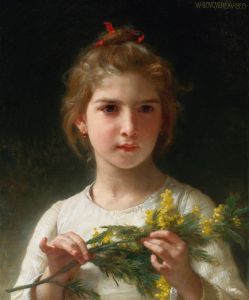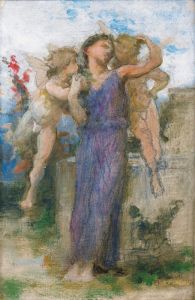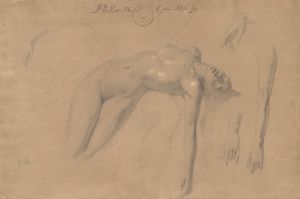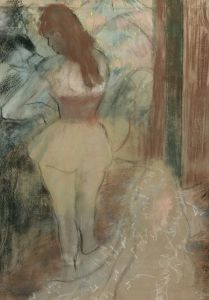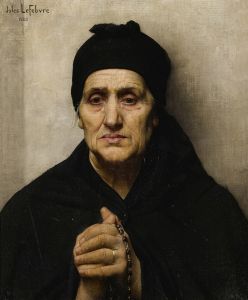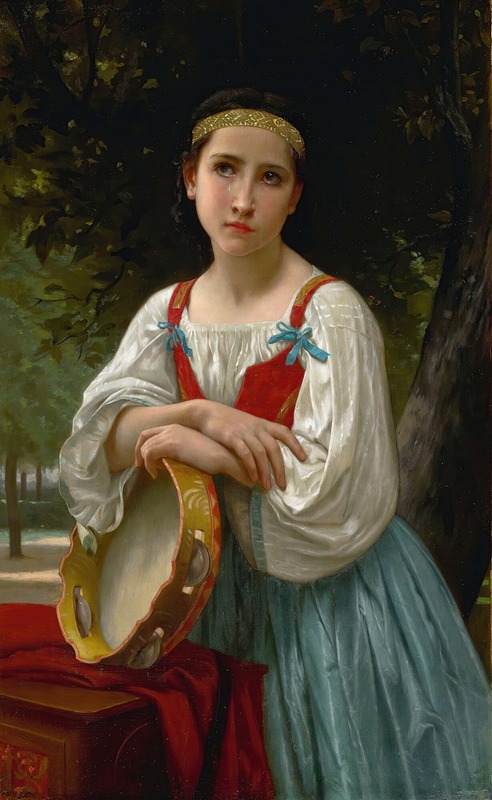
Bohémienne Au Tambour De Basque
A hand-painted replica of William Bouguereau’s masterpiece Bohémienne Au Tambour De Basque, meticulously crafted by professional artists to capture the true essence of the original. Each piece is created with museum-quality canvas and rare mineral pigments, carefully painted by experienced artists with delicate brushstrokes and rich, layered colors to perfectly recreate the texture of the original artwork. Unlike machine-printed reproductions, this hand-painted version brings the painting to life, infused with the artist’s emotions and skill in every stroke. Whether for personal collection or home decoration, it instantly elevates the artistic atmosphere of any space.
"Bohémienne Au Tambour De Basque" (translated as "Gypsy Girl with a Basque Drum") is a painting by the renowned French academic artist William-Adolphe Bouguereau. Created in 1867, this artwork exemplifies Bouguereau's masterful technique and his focus on the human form, particularly the female figure, which is a recurring theme in his extensive body of work.
William-Adolphe Bouguereau (1825-1905) was a prominent 19th-century painter known for his realistic genre paintings and his skillful use of the academic style. He was highly celebrated in his time, receiving numerous awards and honors, and his works were frequently exhibited at the Paris Salon. Bouguereau's paintings often depicted mythological themes, peasant scenes, and portraits, characterized by their meticulous detail, smooth brushwork, and idealized beauty.
"Bohémienne Au Tambour De Basque" features a young Romani girl holding a tambourine, a traditional musical instrument. The girl is depicted in a three-quarter length pose, standing against a neutral background that emphasizes her figure. She is dressed in a simple yet colorful outfit, typical of the Romani people, with a white blouse, a red skirt, and a blue sash. Her dark hair is adorned with a red headscarf, and she gazes directly at the viewer with a serene and contemplative expression.
The painting showcases Bouguereau's exceptional ability to render the human form with lifelike precision. The girl's skin is painted with a soft, luminous quality, and the textures of her clothing and the tambourine are rendered with great attention to detail. The use of light and shadow enhances the three-dimensionality of the figure, creating a sense of depth and realism.
Bouguereau's portrayal of the Romani girl reflects the 19th-century fascination with exoticism and the romanticized view of the "gypsy" lifestyle. During this period, artists and writers often depicted Romani people as free-spirited and connected to nature, though these representations were frequently based on stereotypes rather than accurate cultural understanding.
"Bohémienne Au Tambour De Basque" is a testament to Bouguereau's technical prowess and his ability to capture the beauty and individuality of his subjects. The painting is part of a larger tradition of 19th-century European art that explored themes of ethnicity, identity, and the human condition through idealized representations.
Today, Bouguereau's works, including "Bohémienne Au Tambour De Basque," are held in high regard by art historians and collectors. His paintings can be found in major museums and private collections around the world, where they continue to be admired for their technical excellence and timeless beauty. Bouguereau's legacy as one of the leading figures of academic art remains influential, and his works are studied for their contribution to the development of 19th-century European painting.





